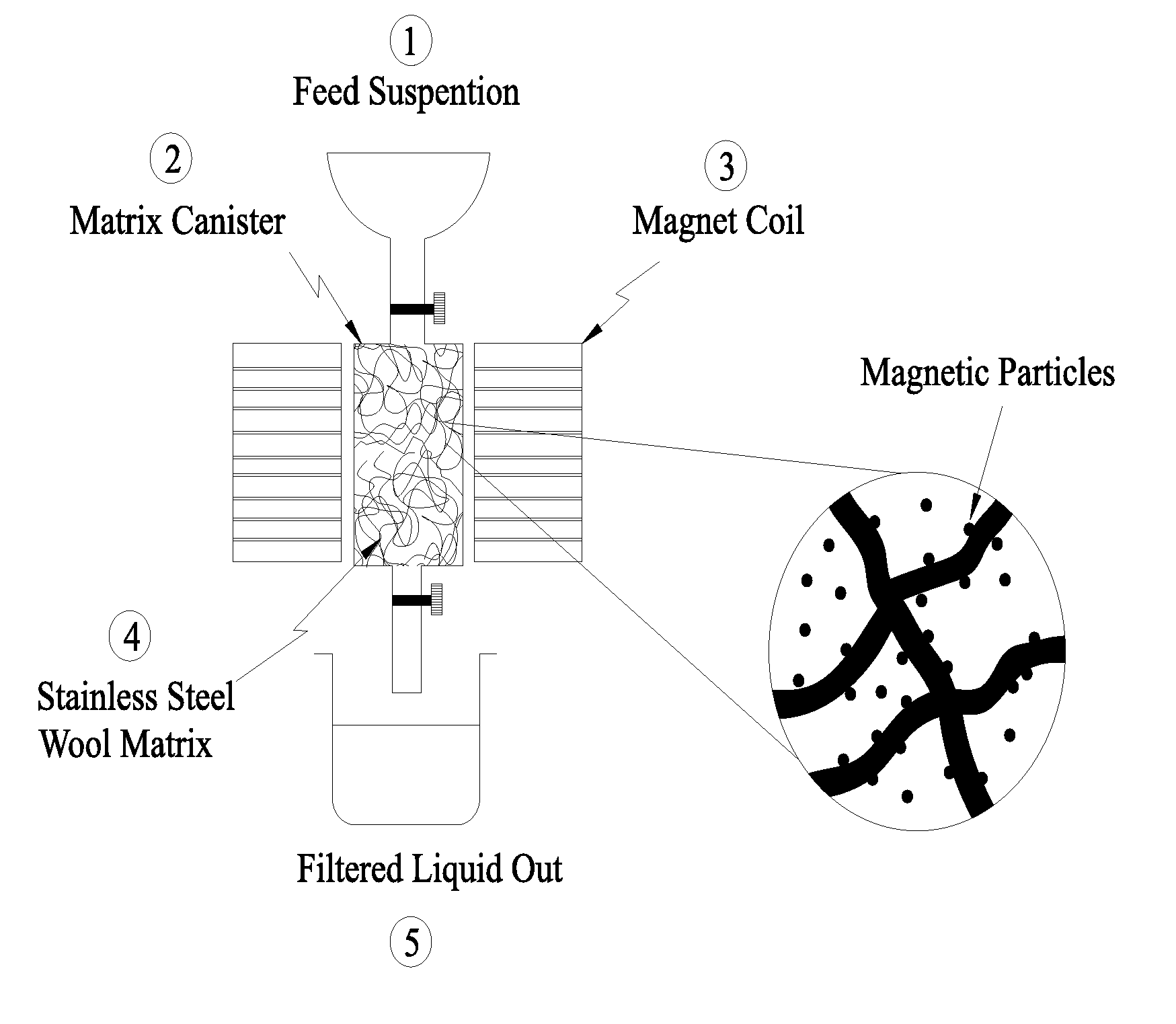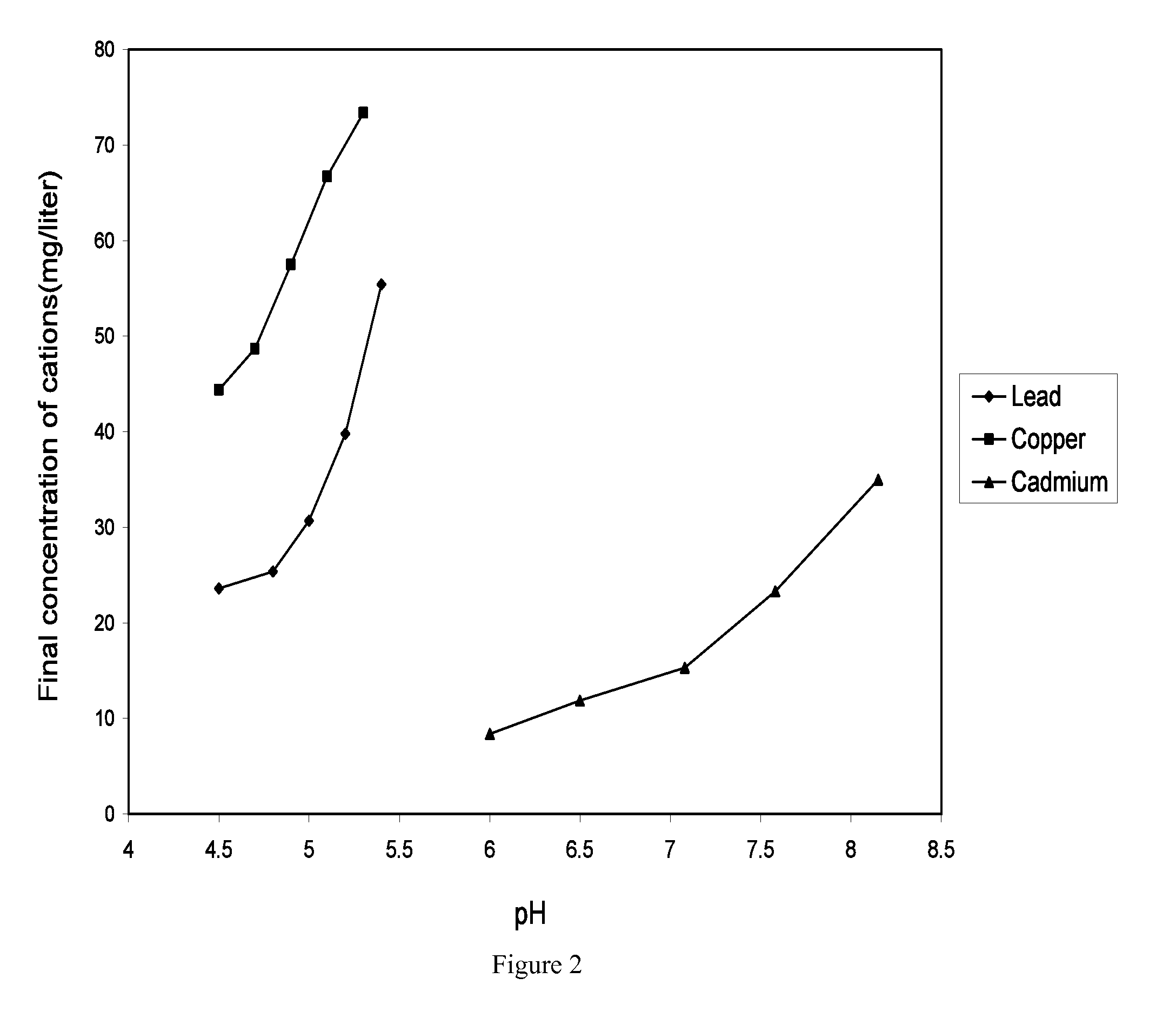Heavy metal cations elimination from aqueous media by nanotechnology
a technology of aqueous media and heavy metal cations, applied in the direction of filtration separation, solid separation, water/sludge/sewage treatment, etc., can solve the problem of permanent magnetism, and achieve the effect of reducing ph and easy replacemen
- Summary
- Abstract
- Description
- Claims
- Application Information
AI Technical Summary
Benefits of technology
Problems solved by technology
Method used
Image
Examples
example 1
[0035]As a result of adsorption of metal cations to the nanoparticles, strong bonds between the metal cations and iron oxide will form which makes it quite difficult to separate them. Indeed, this is a positive parameter for the separation since the ordinary modifications in the effective parameters do not cause the separation of the metal cations from the iron oxide molecules. However this issue is considered a negative point in terms of nanoparticles recycling. The first step in the adsorption tests is the determination of an appropriate limit for pH which itself is a key parameter in the adsorption process and any modification thereof will alter the adsorption degree (due to the change of separation mechanism).
[0036]The results of the adsorption tests are sensitive to pH and any change thereof will bring about a considerable change in adsorption. Any increase in system pH will cause in the sedimentation of metal cations in the form of hydroxide and will make it impossible for the...
example 2
[0039]
TABLE 4Adsorption results of heavy metal cations at different percentage of nanoparticlesCadmiumCopper cationsLead cationsNanoparrticlescations finalfinalfinalContactCations initialmassconcentrationconcentrationconcentrationTimeTemperatureconcentrationpercentage(mg / liter)(mg / liter)(mg / liter)(hours)(° C.)(mg / liter)(gr / liter)45.568.559.82.525400112.744.421.72.52540026.527.39.22.52540032.415.25.32.52540040.24.91.92.5254005
[0040]Table 4 and FIG. 3 contain the adsorption results of heavy metal cations to nanoparticles when the mass percentage of nanoparticles is different.
[0041]Based on the results, it becomes clear that any increase in the nanoparticles mass percentage will increase the metal cations adsorption rate. In addition to the increase in the number of adsorbent sites, the increase in the probability of collision of nanoparticles with the metal cations increases the adsorption rate. On the other hand, the increase in the nanoparticles mass percentage will decrease the ads...
example 3
[0042]
TABLE 5The results of adsorption of heavy metal cations for different initial concentrationsCadmiumCopper cationsLead cationsNanoparticlescations finalfinalfinalContactCations initialmassconcentrationconcentrationconcentrationTimeTemperatureconcentrationpercentage(mg / liter)(mg / liter)(mg / liter)(hours)(° C.)(mg / liter)(gr / liter)1.78.53.42.52510026.819.611.32.525200210.629.817.32.525300216.943.825.62.525400228.358.934.62.5255002
[0043]The results of adsorption of heavy metal cations for different their initial concentrations can be found in table 5 and FIG. 4.
[0044]Despite the fact that it may seem contradictory, the increase in the concentration will increase the adsorption rate of metal cations by nanoparticles as the specific surface of the nanoparticles is high (60 square meters per gram) and the increase in the metal cations concentration does not limit the adsorption rate but will increase the probability of the collision of the cations to the nanoparticles and therefore the ...
PUM
| Property | Measurement | Unit |
|---|---|---|
| Temperature | aaaaa | aaaaa |
| Time | aaaaa | aaaaa |
| Density | aaaaa | aaaaa |
Abstract
Description
Claims
Application Information
 Login to View More
Login to View More - R&D
- Intellectual Property
- Life Sciences
- Materials
- Tech Scout
- Unparalleled Data Quality
- Higher Quality Content
- 60% Fewer Hallucinations
Browse by: Latest US Patents, China's latest patents, Technical Efficacy Thesaurus, Application Domain, Technology Topic, Popular Technical Reports.
© 2025 PatSnap. All rights reserved.Legal|Privacy policy|Modern Slavery Act Transparency Statement|Sitemap|About US| Contact US: help@patsnap.com



